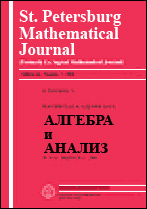|
This article is cited in 21 scientific papers (total in 21 papers)
Research Papers
Weight elements of Chevalley groups
N. Vavilov
St. Petersburg State University, Department of Mathematics and Mechanics
Abstract:
The paper is devoted to a detailed study of some remarkable semisimple elements of (extended) Chevalley groups that are diagonalizable over the ground field — the weight elements. These are the conjugates of certain semisimple elements $h_{\omega}(\varepsilon)$ of extended Chevalley groups $\overline{G}=\overline{G}(\Phi,K)$, where $\omega$ is a weight of the dual root system $\Phi^{\vee}$ and $\varepsilon\in K^*$. In the adjoint case the $h_{\omega}(\varepsilon)$'s were defined by Chevalley himself and in the simply connected case they were constructed by Berman and Moody. The conjugates of $h_{\omega}(\varepsilon)$ are called weight elements of type $\omega$. Various constructions of weight elements are discussed in the paper, in particular, their action in irreducible rational representations and weight elements induced on a regularly embedded Chevalley subgroup by the conjugation action of a larger Chevalley group. It is proved that for a given $x\in\overline{G}$ all elements $x(\varepsilon)=xh_{\omega}(\varepsilon)x^{-1}$, $\varepsilon\in K^*$, apart maybe from a finite number of them, lie in the same Bruhat coset $\overline{B}w\overline{B}$, where $w$ is an involution of the Weyl group $W=W(\Phi)$. The elements $h_{\omega}(\varepsilon)$ are particularly important when $\omega=\varpi_{i}$ is a microweight of $\Phi^{\vee}$. The main result of the paper is a calculation of the factors of the Bruhat decomposition of microweight elements $x(\varepsilon)$ for the case where $\omega=\varpi_{i}$. It turns out that all nontrivial $x(\varepsilon)$'s lie in the same Bruhat coset $\overline{B}w\overline B$, where $w$ is a product of reflections in pairwise strictly orthogonal roots $\gamma_1,\ldots,\gamma_{r+s}$. Moreover, if among these roots $r$ are long and $s$ are short, then $r+2s$ does not exceed the width of the unipotent radical of the $i$th maximal parabolic subgroup in $\overline G$. A version of this result was first announced in a paper by the author in Soviet Math. Doklady in 1988. From a technical viewpoint, this amounts to the determination of Borel orbits of a Levi factor of a parabolic subgroup with Abelian unipotent radical and generalizes some results of Richardson, Röhrle, and Steinberg. These results are instrumental in description of overgroups of a split maximal torus and in the recent papers by the author and V. Nesterov on the geometry of tori.
Keywords:
Chevalley groups, semisimple elements, Bruhat decomposition, microweights, Borel orbits, parabolic subgroups with Abelian unipotent radical.
Received: 06.11.2006
Citation:
N. Vavilov, “Weight elements of Chevalley groups”, Algebra i Analiz, 20:1 (2008), 34–85; St. Petersburg Math. J., 20:1 (2009), 23–57
Linking options:
https://www.mathnet.ru/eng/aa497 https://www.mathnet.ru/eng/aa/v20/i1/p34
|


|





 Contact us:
Contact us: Terms of Use
Terms of Use
 Registration to the website
Registration to the website Logotypes
Logotypes








 Citation in format
Citation in format 
